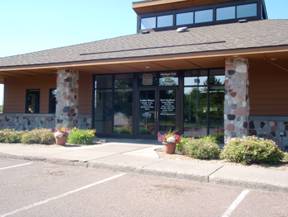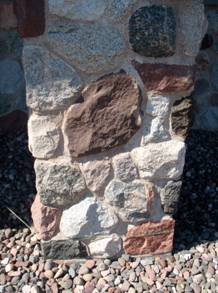
Cache Summary: In the city of Houghton, many buildings are being built and developed and recently among these is the Michigan Tech Employee’s Federal Credit Union. Here you can see different types of rocks that have been cut and cemented together to form pillars and a decorative façade. By exploring this EarthCache, visitors can observe different rock types and infer about their origin.

Figure 1. Michigan Tech Employee’s Federal Credit Union. Photo taken by C. Witt

Figure 2. Pillar at Michigan Tech Employee’s Federal Credit Union. Photo taken by C. Witt
The Credit Union is located on a main road in Houghton and can be easily found using GPS or directions by road.
EarthCache Lesson:
Scientific Question: What different types of rocks are present in the façade of the Michigan Tech Employee’s Federal Credit Union? What can those rocks show us?
Background Information:
Rock Types:
There are three main rock types on Earth: igneous, sedimentary, and metamorphic. By examining the different characteristics of rocks, one can determine what type they are along with seeing other distinguishing marks. These characteristics and marks may give us a peek into the past, geologically and environmentally.
Igneous: these types of rock are formed through lava flows and magma cooling and hardening quickly or slowly. They consist of granite, basalt and contain minerals like quartz, magnesium, irons, silica, feldspar.
Sedimentary rocks form when particles of other rocks (and the minerals they contain) erode away into sediment and then get compressed, making new rock. Materials can get buried with these particles and compressed by layers of rocks, forming fossilized remains in this type of rock. Sandstone, shale, and carbonate (limestone) are all examples of sedimentary rock. You can generally identify them through the presence of layering in the rock. The rock may also feel sandy to the touch.
Metamorphic: these rocks form as rocks change over time. Rocks can change due to pressure, or extreme temperature conditions. New minerals and textures can be formed when these types of rocks form. These new minerals can be seen in bands (called foliation) in metamorphic rocks.
Logging Your Visit:
The rocks on this building, in their current location, are unnaturally occurring. They have been harvested and placed in their present state. Locate west face of the fourth pillar, all the way on the right when looking at the building. You will see a white rock 2.5-3 feet off of the ground.
To obtain credit for visiting this EarthCache, please email me the response to the following questions:
-Logging Question 1: What type of rock is the white rock?
-Logging Question 2: Do you think this white rock was originally laid down with the same orientation as it has been placed here? Why?
-Logging Question 3: Describe at least two other rocks you see.
-Bonus Question #1: What do you think could have formed the patterning you see on the white rock?
-Bonus Question #2: If this entire pillar wasn’t man-made, what type of rock would it be and why?
Earth Science Literacy Principles Big Ideas:
Big Idea #7: Humans depend on earth for resources.
Humans need resources from the ground like water, oils, and minerals in order to function the way we do. The rocks in the building give it structure along with aesthetics that humans look for in a fancy facade. The rocks are not manmade and are another example of a resource humans use from the Earth.
Common Earth Science Misconceptions:
A common misconception in Earth Science is that all rocks are more or less the same (a rock is a rock!). As in this EarthCache site, rocks are very different in texture, color, and other characteristics. These characteristics classify them as one of the three rock types: igneous, sedimentary, or metamorphic.
References:
Rose, Bill. MiTEP website. Retrieved from:
http://www.geo.mtu.edu/~raman/SilverI/HoughtonEC/Welcome.html
Schaetzl, R., Darden, J., & Brandt, D. (2009). Michigan Geography and Geology. New York: Pearson.